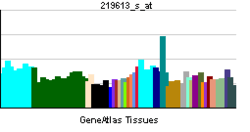SIRT6
| View/Edit Human | View/Edit Mouse |
Sirtuin-6 (SIRT6) is a stress responsive protein deacetylase and mono-ADP ribosyltransferase enzyme encoded by the SIRT6 gene.[3][4] SIRT6 functions in multiple molecular pathways related to aging, including DNA repair, telomere maintenance, glycolysis and inflammation.[3]
Function
Studies in mice have revealed that Sirt6 is essential for post-natal development and survival. Sirt6 knock-out mice, in which the gene encoding Sirt6 has been disrupted, exhibit a severe progeria, or premature aging syndrome, characterized by spinal curvature, greying of the fur, lymphopenia and low levels of blood glucose.[5] The lifespan of Sirt6 knock-out mice is typically one to three months, dependent upon the strain in which the Sirt6 gene has been deleted. By contrast, wild type mice, which retain expression of Sirt6, exhibit a maximum lifespan of two to four years.[5]
Mice which have been genetically engineered to overexpress, or produce more, Sirt6 protein exhibit an extended maximum lifespan. This lifespan extension, of about 15-16 percent, is observed only in male mice.[6] Reciprocal regulation between SIRT6 and miRNA-122 controls liver metabolism and Predicts Hepatocarcinoma prognosis by study of Haim Cohen's lab with mice. they found that SIRT6 and miR-122 negatively regulate each other's expression. The study found SIRT6 was shown to act as a tumor suppressor that blocks the Warburg effect in cancer cells. [7]
Clinical relevance
The medical and therapeutic relevance of SIRT6 in humans remains unclear. SIRT6 may be an attractive drug target for pharmocological activation in several diseases.[8] Because SIRT6 attenuates glycolysis and inflammation, the gene is of medical interest in the context of several diseases, including diabetes and arthritis.[9] Additionally, SIRT6 may be relevant in the context of cancer. Several studies have indicated that SIRT6 is selectively inactivated during oncogenesis in a variety of tumor types; a separate study demonstrated that SIRT6 overexpression was selectively cytotoxic to cancer cells.[10]
References
- ↑ "Human PubMed Reference:".
- ↑ "Mouse PubMed Reference:".
- 1 2 Frye RA (Aug 2000). "Phylogenetic classification of prokaryotic and eukaryotic Sir2-like proteins". Biochem Biophys Res Commun. 273 (2): 793–8. doi:10.1006/bbrc.2000.3000. PMID 10873683.
- ↑ "Entrez Gene: SIRT6 sirtuin (silent mating type information regulation 2 homolog) 6 (S. cerevisiae)".
- 1 2 Lombard DB, Schwer B, Alt FW, Mostoslavsky R (February 2008). "SIRT6 in DNA repair, metabolism and ageing". J. Intern. Med. 263 (2): 128–41. doi:10.1111/j.1365-2796.2007.01902.x. PMC 2486832
 . PMID 18226091.
. PMID 18226091. - ↑ Kanfi Y, Naiman S, Amir G, Peshti V, Zinman G, Nahum L, Bar-Joseph Z, Cohen HY (March 2012). "The sirtuin SIRT6 regulates lifespan in male mice". Nature. 483 (7388): 218–21. doi:10.1038/nature10815. PMID 22367546.
- ↑ http://www.cell.com/cell-reports/references/S2211-1247(15)01436-9
- ↑ Cen Y, Youn DY, Sauve AA (2011). "Advances in characterization of human sirtuin isoforms: chemistries, targets and therapeutic applications". Curr. Med. Chem. 18 (13): 1919–35. doi:10.2174/092986711795590084. PMID 21517779.
- ↑ Liu TF, Vachharajani VT, Yoza BK, McCall CE (June 2012). "NAD+-dependent sirtuins 1 and 6 coordinate a switch from glucose to fatty acid oxidation during the acute inflammatory response". J Biol Chem. 287 (31): 25758–69. doi:10.1074/jbc.M112.362343. PMID 22700961.
- ↑ Van Meter M, Mao Z, Gorbunova V, Seluanov A (September 2011). "SIRT6 overexpression induces massive apoptosis in cancer cells but not in normal cells". Cell Cycle. 10 (18): 3153–8. doi:10.4161/cc.10.18.17435. PMC 3218623
 . PMID 21900744.
. PMID 21900744.
Further reading
- Maruyama K, Sugano S (1994). "Oligo-capping: a simple method to replace the cap structure of eukaryotic mRNAs with oligoribonucleotides". Gene. 138 (1–2): 171–4. doi:10.1016/0378-1119(94)90802-8. PMID 8125298.
- Suzuki Y, Yoshitomo-Nakagawa K, Maruyama K, et al. (1997). "Construction and characterization of a full length-enriched and a 5'-end-enriched cDNA library". Gene. 200 (1–2): 149–56. doi:10.1016/S0378-1119(97)00411-3. PMID 9373149.
- Strausberg RL, Feingold EA, Grouse LH, et al. (2003). "Generation and initial analysis of more than 15,000 full-length human and mouse cDNA sequences". Proc. Natl. Acad. Sci. U.S.A. 99 (26): 16899–903. doi:10.1073/pnas.242603899. PMC 139241
 . PMID 12477932.
. PMID 12477932. - Ota T, Suzuki Y, Nishikawa T, et al. (2004). "Complete sequencing and characterization of 21,243 full-length human cDNAs". Nat. Genet. 36 (1): 40–5. doi:10.1038/ng1285. PMID 14702039.
- Grimwood J, Gordon LA, Olsen A, et al. (2004). "The DNA sequence and biology of human chromosome 19". Nature. 428 (6982): 529–35. doi:10.1038/nature02399. PMID 15057824.
- Gerhard DS, Wagner L, Feingold EA, et al. (2004). "The status, quality, and expansion of the NIH full-length cDNA project: the Mammalian Gene Collection (MGC)". Genome Res. 14 (10B): 2121–7. doi:10.1101/gr.2596504. PMC 528928
 . PMID 15489334.
. PMID 15489334. - Stelzl U, Worm U, Lalowski M, et al. (2005). "A human protein-protein interaction network: a resource for annotating the proteome". Cell. 122 (6): 957–68. doi:10.1016/j.cell.2005.08.029. PMID 16169070.
- Rual JF, Venkatesan K, Hao T, et al. (2005). "Towards a proteome-scale map of the human protein-protein interaction network". Nature. 437 (7062): 1173–8. doi:10.1038/nature04209. PMID 16189514.
- Parenti MD, Grozio A, Bauer I, et al. (2014). "Discovery of novel and selective SIRT6 inhibitors". J. Med. Chem. 57 (11): 4796–804. doi:10.1021/jm500487d. PMID 24785705.
